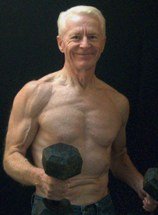Hi

January 15, 2013
In this newsletter . . .
What Are Solid
Fitness Programs
for Mature Adults?
The January 1st newsletter (Insanity Workouts: Are They Safe for Seniors?) generated plenty of comments about high intensity training.
Some people wrote about following some of the well-known high intensity programs once a week, but doing more moderate training on the other days. They asked what I thought about that idea as a way of pushing themselves but also staying age appropriate. If they were what I call “young seniors,” those in their early fifties, and enjoying the training, then what they are doing seems reasonable to me.
Some subscribers brought up questions about specific programs I had never heard of. One of them, as an example, referred to Zumba Gold. Zumba, I know, is a popular dance based fitness program. I learned that Zumba Gold is a tamer version of it, for older adults. Other programs I was not very familiar with came up too, and I was asked to comment on them.
Generally, as I explained in the January 1st newsletter, high-intensity training gets riskier as we get older. So be prudent. Then there were some questions about what exactly constitutes a solid fitness program for seniors? Here are a few guidelines that I recommend:
1. All balanced fitness programs should include elements of (a) strength training, (b) cardiovascular exercise, and (c) flexibility movements. Based on personal preferences and goals, you can put emphasis on either a, b, or c; but totally ignoring any one of them will not provide a balanced fitness program. Some circuit training arrangements can combine all three elements in a single workout, or, of course, they can be split into separate segments.
2. Don’t do marathon workout sessions. Generally, anything over an hour in a gym is too much. Less than an hour is usually even better, provided that it is time spent training, not standing around talking. Yes, I know Jack LaLanne is said to have been doing two-hour-plus workouts into his nineties. But are you Jack LaLanne? I’m not. He was one in a million. Keep it real.
3. Cross training can be fun because changes of routine tend to keep things interesting, and overuse injuries are more preventable than when doing the same movements over-and-over, month-after-month, year-after-year.
4. Select exercise programs that appeal to you. And there’s certainly nothing wrong with experimenting with different options. Group exercise programs, for example, are just the things for some people. Whether training in groups or training alone, strength, cardiovascular and flexibility training can be done using only your own bodyweight exercises. On the other hand, why not use free weights, resistance bands or kettlebells if they are available to you? There are lots of options.
But if you find you dislike what it is you’re doing, move on. There is a training lifestyle for every taste and to meet every goal. Discover yours and be happy.

You've probably heard about the tremendous benefits of weight training and how you can retain -- or even reclaim -- the attributes of youth . . . Discover the way with . . .
Gray Iron: A Fitness Guide for Senior Men and Women


Newsletter Policy
The Gray Iron Fitness Newsletter is a free publication sent twice monthly to subscribers. The purpose is to provide honest and realistic fitness information for people age 50 and above.
I have never been paid or received compensation of any kind to write a positive review or endorse a product. If I say that I personally use a product or service, it is because I find value in it and have paid for it with my own money.
Like newspapers, magazines and television, this newsletter and my web site contain advertising and marketing links. Naturally, I am compensated for these.
The newsletter and web site provide information to help users establish and maintain a fitness lifestyle. But fitness information is not the same as fitness advice, which is the application of exercise and dietary practices to an individual's specific circumstances. Therefore, always consult with your physician for assurance that fitness information, and your interpretation of it, is appropriate for you.Your comments and questions are always appreciated. Simply click on the "Reply" bottom.
Sincerely,
Logan Franklin
The Gray Iron Fitness Newsletter
www.senior-exercise-central.com



